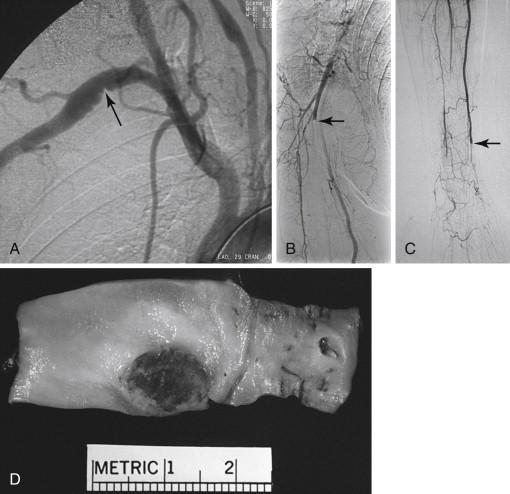Physical Address
304 North Cardinal St.
Dorchester Center, MA 02124
Subclavian and axillary artery aneurysms account for less than 1% of all peripheral artery aneurysms. Among 1488 patients with atherosclerotic aneurysms reported from the University of Michigan by Dent and colleagues in 1972, only two subclavian and no axillary artery aneurysms were identified. Treatment of these aneurysms has evolved from ligation or exclusion, as first successfully performed by Smythe in New Orleans in 1864, to aneurysm resection with prosthetic or autogenous interposition grafts. In recent years, covered flexible stents have been used for repair, though their long-term durability remains in question.
Subclavian artery aneurysms are the most common in the brachiocephalic region, if those involving the distal subclavian and proximal axillary artery caused by thoracic outlet compression are included. The right subclavian is involved more often than the left. Atherosclerosis is the etiology in 34% to 50% of these aneurysms, and it is the most common cause of proximal subclavian artery aneurysm. In contrast, thoracic outlet compression remains the most common cause of distal subclavian and proximal axillary artery aneurysms, occurring in 39% of patients in a report from the Mayo Clinic in 1991 and 31% in the more recent experience. Trauma leading to false aneurysm, connective tissue disease, fibromuscular dysplasia, arteritis, and dissection are other etiologies.
These aneurysms are diagnosed in men almost twice as often as in women, with intrathoracic aneurysms occurring more often in men, and those related to thoracic outlet syndrome (TOS) seen more commonly in women. The latter finding may be related to the higher prevalence of cervical ribs and TOS in women. These aneurysms occur over a wide range of ages, but usually they are detected in the fifth and sixth decades of life. Importantly, as many as one fifth to one half of patients with subclavian aneurysms have aneurysms of the descending thoracic, thoracoabdominal, or abdominal aorta; the contralateral subclavian artery; or the visceral arteries, in decreasing order of frequency.
Nearly two thirds of patients are symptomatic at diagnosis, with neck and upper extremity pain from the compressive effect of the aneurysm the most common presentation ( Table 1 ). Among our most recent 49 treated patients, symptoms occurred in 91% of patients with distal subclavian aneurysms, 61% with subclavian aneurysms, and 37% with proximal aneurysms.
| Signs and Symptoms | Percentage |
|---|---|
| Symptoms in 27 Patients | |
| Neck and upper extremity pain | 93 |
| Paresthesias | 30 |
| Cold upper extremity | 30 |
| Exertional fatigue | 24 |
| Paresis | 10 |
| Transient ischemic attack or stroke | 10 |
| Signs in 31 Patients | |
| Pulsatile neck mass/bruit (includes 13 asymptomatic patients) | 37 |
| Decreased or absent pulses | 33 |
| Pallor | 33 |
| Neurologic deficit | 10 |
| Digital emboli | 8 |
| Other Signs | |
| Distal thromboembolism in 7 patients | 15 |
| Cerebral embolism in 5 patients | 10 |
Rupture and thromboembolism are the major complications of these aneurysms. The latter causes arm or hand ischemia or vertebral or carotid stroke by retrograde propagation and washout of thrombus. Chronic repetitive upper extremity or digital emboli from ulceration within a subclavian artery compressed by a cervical rib is a diagnosis that may be confused with collagen vascular disorders or inflammatory processes involving the small and medium-sized arteries of the extremity ( Figure 1 ). Such presentations delay diagnosis. Nehler and colleagues reported the average time between onset of digital ischemia and diagnosis of the aneurysm to average 7 months, ranging as long as 36 months.

Rupture is rare, but it occurs in patients with large atherosclerotic, infected, traumatic, or aberrant subclavian aneurysms. Patients can quickly succumb from uncontrolled hemorrhage into the pleural space, the soft tissues of the neck, or the adjacent trachea or esophagus.
An aberrant right subclavian artery is a common aortic arch anomaly. It occurs in approximately 0.5% of the population. The artery originates distal to the left subclavian origin on the posterior and inferior part of the arch, and it crosses the midline between the esophagus and the spine, where it assumes a normal anatomic position in the right neck. The aberrant artery may be associated with a large posteromedial diverticulum at its origin (Kommerell diverticulum). Similar to other vestigial arteries, aberrant subclavian arteries are prone to aneurysmal degeneration.
Kieffer, Bahnini, and Koskas have described other anatomic variations that occur with aberrant subclavian artery aneurysms, including a common carotid trunk, abnormal origin of the vertebral artery from the ipsilateral common carotid artery or the aortic arch, a right-sided thoracic duct, and a nonrecurrent laryngeal nerve. These anomalies become important during open reconstructions.
Aneurysms of the proximal and mid artery cause difficulty in swallowing by esophageal compression, called dysphagia lusoria, as described by Bayford in 1794. This syndrome was most common in the study by Kieffer, Bahnini, and Koskas, occurring in 58% of patients. Respiratory problems are more common in children with this anomaly. A report of 24 patients with aberrant nonaneurysmal right subclavian arteries from the Mayo Clinic in 2011 found the anomaly more common in women. Eight patients (33%) had dysphagia, upper extremity ischemia, or both. All seven patients (29%) with a Kommerell diverticulum had aneurysms of the aberrant artery. Atherosclerosis is the most common histologic finding.
Become a Clinical Tree membership for Full access and enjoy Unlimited articles
If you are a member. Log in here